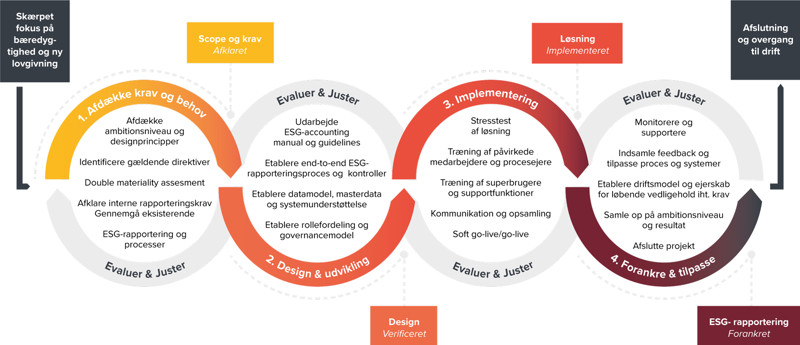Are you about to implement ESG reporting or to calibrate as regards CSRD ...
... then we can help you prepare an ESG roadmap and plan ensuring operational embeddedness. We use Basico's Change Model, which is a stepwise approach to the steps that it is necessary to take to achieve the very best outcome when developing and embedding the ESG reporting process.

The model divides the process into four phases. The specific work with the model is adjusted to the specific company, industry, and size, but one example may look like this:
Phase 1 | Identify requirements and needs
- Establish level of ambition and design principles – Why report on ESG? Who makes the requirements? Which value is the ESG reporting expected to create? What are the success criteria? And are there any limitations that need to be considered?
- Identify the applicable directives – such as CSRD/ESRS and EU taxonomy.
- ’Double materiality assessment’ – methodological and pragmatic review of ESRS to identify material reporting requirements and document any deselections.
- Identify internal reporting requirements - as regards continuous reporting and decision processes as well as any monitoring of sustainable investments.
- Go through existing ESG reporting and processes - to identify the existing maturity of the ESG reporting process as well as any deficiencies as regards ownership, ESG accounting manual, systems, controls, etc.
Phase 2 | Design and development
- Prepare ESG accounting manual and guidelines – to ensure clear definitions of KPIs and rules on materiality and deviations so that you acquire the desired data quality.
- Establish end-to-end ESG reporting processes and controls.
- Establish data model, master data, and system support – including preparation of a specification of requirements as well as an analysis of the possibilities of using an existing platform or third-party systems, if relevant. This also includes the design and development of templates, data integration, consolidation, and establishment of a control environment.
- Establish the distribution of roles and a governance mode – Who does what when across the business, IT and Finance?
Phase 3 | Implementation
- Stress test of solution – It is important to test a process before implementation because it may reveal any problems and potential for improvements before they become a part of day-to-day operations. By testing a process, you can identify whether it works as intended. You can also identify whether it is effective and meets the requirements intended across the organisation, including subsidiaries in other countries where the availability of data and the cultural understanding of ESG deviate from that in the Nordic countries.
- Training of the employees and process owners affected – thereby ensuring that the process has been understood and accepted.
- Training of super users and support functions – to ensure bottlenecks related to support and to ensure a wider embeddedness of ESG in the form of local or regional ambassadors.
- Communication and summing up – The message about 'why' may be decisive to achieve sufficient adoption of the process.
- Soft go-live or go-live – Recognition of the situation and any dependencies and outstanding issues.
Phase 4 | Embeddedness and alignment
- Monitor and support – to remedy any unforeseen issues, deficiencies, or defects early in the process.
- Get feedback – Adjust the process and systems to address any challenges related to the interpretation or execution in connection with tasks/responsibilities and to ensure that you end up having the desired behaviour.
- Establish an operating model and ownership – to ensure continuous maintenance according to the requirements so that the continuous operation and maintenance of processes, templates, master data, manuals, etc. is handled timely.
- Sum up as regards level of ambition and result – both to ensure compliance with the expected scope and to mark the transition from project to operation.
- Complete the project..

ESG Reporting Services
At ESG Reporting Services, we help companies with the entire ESG spectrum – from strategic advisory and reporting to specialised compliance areas such as EUDR and VSME implementation.
We offer flexible ESG solutions – from risk assessments and defining reporting scope to hands-on implementation, interim support and ESG-as-a-Service for companies that do not need an internal ESG resource.

ESG-as-a-Service
What if you want a flexible ESG department on a part-time basis? The short answer is: You can.
At Basico, we call it ESG-as-a-Service, where you get access to an experienced ESG expert who knows your team and follows your company, and who has a large network of knowledge to draw upon.

ESG operating model
Do you need a new ESG reporting software? This is one of the questions that you can find an answer to by means of Basico's ESG operating model. It helps you divide the reporting task into processes, competences, systems, guidelines (governance), management and culture. On the basis of the model, we can establish the building blocks needed to handle ESG reporting in an operational and structured way.
Would you like more information?


 en
en
 da
da
